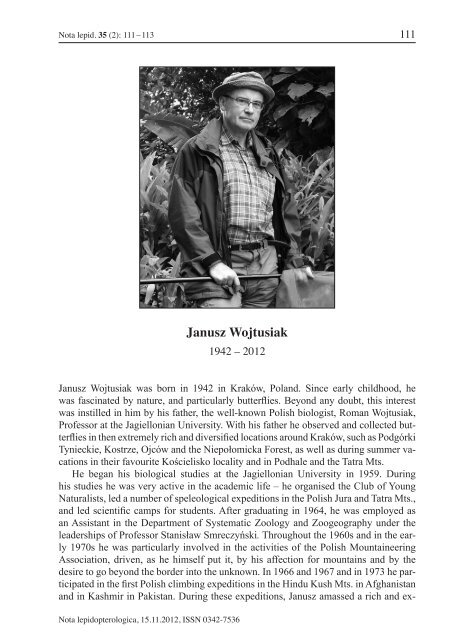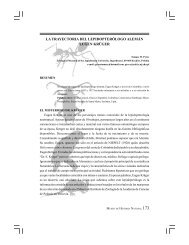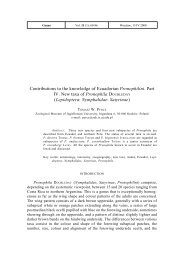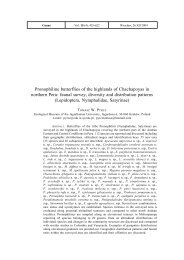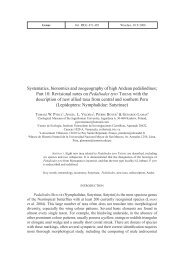Janusz Wojtusiak
Janusz Wojtusiak
Janusz Wojtusiak
- No tags were found...
Create successful ePaper yourself
Turn your PDF publications into a flip-book with our unique Google optimized e-Paper software.
Nota lepid. 35 (2): 111 – 113111<strong>Janusz</strong> <strong>Wojtusiak</strong>1942 – 2012<strong>Janusz</strong> <strong>Wojtusiak</strong> was born in 1942 in Kraków, Poland. Since early childhood, hewas fascinated by nature, and particularly butterflies. Beyond any doubt, this interestwas instilled in him by his father, the well-known Polish biologist, Roman <strong>Wojtusiak</strong>,Professor at the Jagiellonian University. With his father he observed and collected butterfliesin then extremely rich and diversified locations around Kraków, such as PodgórkiTynieckie, Kostrze, Ojców and the Niepołomicka Forest, as well as during summer vacationsin their favourite Kościelisko locality and in Podhale and the Tatra Mts.He began his biological studies at the Jagiellonian University in 1959. Duringhis studies he was very active in the academic life – he organised the Club of YoungNaturalists, led a number of speleological expeditions in the Polish Jura and Tatra Mts.,and led scientific camps for students. After graduating in 1964, he was employed asan Assistant in the Department of Systematic Zoology and Zoogeography under theleaderships of Professor Stanisław Smreczyński. Throughout the 1960s and in the early1970s he was particularly involved in the activities of the Polish MountaineeringAssociation, driven, as he himself put it, by his affection for mountains and by thedesire to go beyond the border into the unknown. In 1966 and 1967 and in 1973 he participatedin the first Polish climbing expeditions in the Hindu Kush Mts. in Afghanistanand in Kashmir in Pakistan. During these expeditions, <strong>Janusz</strong> amassed a rich and ex-Nota lepidopterologica, 15.11.2012, ISSN 0342-7536
112 Obituary: <strong>Janusz</strong> <strong>Wojtusiak</strong> (1942 – 2012)tremely valuable collection of butterflies including several thousands of rare specimensof Parnassius, as well as Baltia whites and Karanasa satyrines. As <strong>Janusz</strong> recalled,when other members of the expeditions were occupied with climbing the snow-coveredpeaks, he was rather interested in penetrating the high-mountain valleys in search ofinteresting insects. The material brought from these expeditions enriched the collectionof the Zoological Museum of the Jagiellonian University. During expeditions to Asia,he also shot many hours of documentary films that have recently been converted intodigital format.His Ph.D. thesis, presented in 1971, concerned the morphology of microlepidopteransfrom the family Adelidae and was one of the pioneering studies of this group. Hedescribed in detail and illustrated the female copulatory apparatus of adelids, togetherwith its associated musculature. Soon after gaining the title of doctor habilitatus atthe beginning of the 1980s, he was appointed Head of the Zoological Museum of theJagiellonian University. Immediately afterwards, he was offered a contract to teach ata university in Nigeria, which, in these difficult times, provided him with a rare opportunityto receive a decent salary as a Polish academic teacher. Between 1982 and1986, <strong>Janusz</strong> taught zoology and entomology at the University of Nigeria in Nsukka.Throughout that period, he spent almost all his free time undertaking excursions intoforests and savannas looking for interesting film footage and insects for the scientificcollection of the Zoological Museum. The material collected by him, principally insoutheastern Nigeria, in the Nsukka and Okomu forests, as well as the Obudu and Obanmountains, includes thousands of specimens and is one of the most exhaustive collectionsof butterflies and moths from this region in the world. Many specimens constitutedspecies new to science, described later by specialists in various groups, and the numberof type specimens deposited in Kraków elevated the scientific value of the collection atthe Jagiellonian. Another scientific result of his stay in Nigeria was the description of anew morphological organ in the ants of the genus Oecophylla, namely pretarsal pads,which allow these insects to push large prey on smooth and almost vertical surfaces.After returning from Nigeria, <strong>Janusz</strong> continued his research in the field of entomology.His interests focused on circadian cycles in insects, various aspects of the behaviourof social insects such as ants, bees, and termites, as well as issues in taxonomy andthe faunistics of butterflies.In 1989 and 1990 he gave lectures in forest entomology at the invitation of theUniversity of Wisconsin in Stevens Point. At that time he started an active co-operationwith the leading zoological museums in Europe and the United States, above all withthe Natural History Museum in London. This project aimed at producing a comprehensivework detailing the scientific collection of butterflies in the Zoological Museum ofthe Jagiellonian University. In 1991, he published a textbook on the ethology of insects,which is the only such comprehensive treatment of this topic in the Polish language todate. For several years, <strong>Janusz</strong> continued his studies aimed at updating and publishinga new edition of this textbook, but these plans were thwarted by his illness. At the turnof the 1980s and 1990s he again collected butterflies in tropical countries on severaloccasions: in India and Tanzania, and under the scientific programme of the ZoologicalMuseum in Sao Tome and Principe. The latter expeditions have again resulted in very
Nota lepid. 35 (2): 111 – 113113interesting scientific material serving as a source for a number of scientific publicationsconcerning, inter alia, fauna, and taxonomy, including new species, as well as variousaspects of the biology and ecology of butterflies of that region.In 1994, <strong>Janusz</strong> received a professorial nomination from the President of the Republicof Poland, Lech Wałęsa. Fom the mid 1990s, the scientific interests of Professor <strong>Janusz</strong><strong>Wojtusiak</strong> were geared towards the mountainous areas of South America, as he noticedthe hidden scientific potential in the mostly unknown fauna of many groups of butterfliesof this region. From 1996 he either participated in or organised more than ten scientificexpeditions into the Andes: in 1996 into the Cordillera de Merida in Venezuela;in 1997 to western Colombia; in 1998 to northern Peru; in 2000 and again in 2008 toBolivia; in 2002 to central Peru; several times to Ecuador from 2002 to 2004, under theproject sponsored by the State Committee for Scientific Research (KBN); and in 2007again to Venezuela. During these scientific expeditions, extraordinarily valuable andextensive material of a large number of various lepidopteran groups across the wholeorder were collected, which resulted in more than 100 scientific publications and descriptionsof more than 400 new species of butterflies and moths, principally belongingto Tortricidae, in co-authorship with Professor Józef Razowski. Together with the latter,<strong>Janusz</strong> described a new olfactory organ located on the abdomen of the African representativesof Adelidae. One of his most interesting achievements was discovering anddescribing the first brachypterous and non-flying male moth in the world, in the genusXenomigia (Notodontidae).<strong>Janusz</strong> was the initiator of research and teaching co-operation agreements betweenthe Jagiellonian University and several leading scientific institutions and universitiesin South America, including the Venezuelan Institute for Scientific Research and theNational University of San Marcos in Lima. These agreements facilitated to a greatextent the research activities of scientific staff, doctoral students, and undergraduates ofthe Jagiellonian University, carried out in the almost uncharted mountainous forests ofthis continent. The exploration of the Andes placed the Zoological Museum on the listof the most highly regarded museums and research institutions in Europe with respectto the studies of butterfly fauna and global biodiversity.<strong>Janusz</strong> was an academic teacher highly regarded and well liked by his students. Formany years he had taught the ethology of insects, zoogeography, and entomological techniques.Since 2007 he had co-organised and was one of the lecturers in Tropical Ecology,a course whose fieldwork component was being undertaken each year in Venezuela – firstsuch course in Poland. In recent years he devoted much time to his new hobby, makingfilms about nature. He shot and edited many hours of documentaries that are used asteaching aids and in the promotional activities of the Jagiellonian University.He filled his free time with making field excursions in the Tatras, Alps, and RockyMountains, from which he always brought back interesting insect specimens. <strong>Janusz</strong>was a very active advocate for the establishment of a new chair at the ZoologicalMuseum of the Jagiellonian University and for creating a modern basis for teachingwithin the Centre for Natural Sciences Education, whose planning he supervised as asenior consultant.Tomasz W. Pyrcz


